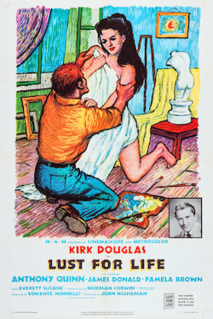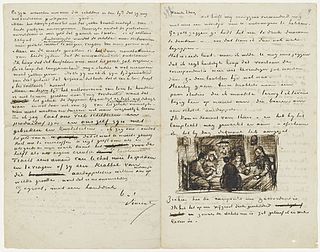
Vincent Willem van Gogh was a Dutch Post-Impressionist painter who posthumously became one of the most famous and influential figures in Western art history. In a decade, he created about 2,100 artworks, including around 860 oil paintings, most of which date from the last two years of his life. They include landscapes, still lifes, portraits, and self-portraits, and are characterised by bold colours and dramatic, impulsive and expressive brushwork that contributed to the foundations of modern art. He was not commercially successful, struggled with severe depression and poverty, and committed suicide at the age of 37.

Lust for Life is a 1956 American biographical film about the life of the Dutch painter Vincent van Gogh, based on the 1934 novel of the same title by Irving Stone which was adapted for the screen by Norman Corwin.

Café Terrace at Night is an 1888 oil painting by the Dutch artist Vincent van Gogh. It is also known as The Cafe Terrace on the Place du Forum, and, when first exhibited in 1891, was entitled Coffeehouse, in the evening.
The Starry Night is an 1889 painting by Vincent van Gogh.
A reaper is a farm tool or machine for harvesting grain.

Vincent van Gogh made many copies of other people's work between 1887 and early 1890, which can be considered appropriation art. While at Saint-Paul asylum in Saint-Rémy-de-Provence, France, where Van Gogh admitted himself, he strived to have subjects during the cold winter months. Seeking to be reinvigorated artistically, Van Gogh did more than 30 copies of works by some of his favorite artists. About twenty-one of the works were copies after, or inspired by, Jean-François Millet. Rather than replicate, Van Gogh sought to translate the subjects and composition through his perspective, color, and technique. Spiritual meaning and emotional comfort were expressed through symbolism and color. His brother Theo van Gogh would call the pieces in the series some of his best work.

This is a list that shows references made to the life and work of Dutch artist Vincent van Gogh (1853–1890) in culture.

Wheat Fields is a series of dozens of paintings by Dutch Post-Impressionist artist Vincent van Gogh, borne out of his religious studies and sermons, connection to nature, appreciation of manual laborers and desire to provide a means of offering comfort to others. The wheat field works demonstrate his progression as an artist from the drab Wheat Sheaves made in 1885 in the Netherlands to the colorful and dramatic 1888–1890 paintings from Arles, Saint-Rémy and Auvers-sur-Oise in rural France.

Vincent van Gogh enjoyed making Paintings of Children. He once said that it's the only thing that "excites me to the depths of my soul, and which makes me feel the infinite more than anything else." Painting children, in particular represented rebirth and the infinite. Over his career Van Gogh did not make many paintings of children, but those he completed were special to him. During the ten years of Van Gogh's career as a painter, from 1881 to 1890, his work changed and grew richer, particularly in how he used color and techniques symbolically or evocatively.

The early works of Vincent van Gogh comprise a group of paintings and drawings that Vincent van Gogh made when he was 27 and 28, in 1881 and 1882, his first two years of serious artistic exploration. Over the course of the two-year period Van Gogh lived in several places. He left Brussels, where he had studied for about a year in 1881, to return to his parents’ home in Etten, where he made studies of some of the residents of the town. In January 1882 Van Gogh went to The Hague where he studied with his cousin-in-law Anton Mauve and set up a studio, funded by Mauve. During the ten years of Van Gogh's artistic career from 1881 to 1890 Vincent's brother Theo would be a continuing source of inspiration and financial support; his first financial support began in 1880 funding Vincent while he lived in Brussels.

Peasant Character Studies is a series of works that Vincent van Gogh made between 1881 and 1885.

Van Gogh's family in his art refers to works that Vincent van Gogh made for or about Van Gogh family members. In 1881, Vincent drew a portrait of his grandfather, also named Vincent van Gogh, and his sister Wil. While living in Nuenen, Vincent memorialized his father in Still Life with Bible following his death in 1885. There he also made many paintings and drawings in 1884 and 1885 of his parent's vicarage, its garden and the church. At the height of his career in Arles he made Portrait of the Artist's Mother, Memory of the Garden at Etten of his mother and sister and Novel Reader, which is thought to be of his sister, Wil.

The Letters of Vincent van Gogh refers to a collection of 903 surviving letters written (820) or received (83) by Vincent van Gogh. More than 650 of these were from Vincent to his brother Theo. The collection also includes letters van Gogh wrote to his sister Wil and other relatives, as well as between artists such as Paul Gauguin, Anthon van Rappard, and Émile Bernard.

At Eternity's Gate is a 2018 biographical drama film about the final years of painter Vincent van Gogh's life. The film dramatizes the controversial theory put forward by van Gogh biographers Steven Naifeh and Gregory White Smith, in which they speculate that van Gogh's death was caused by mischief rather than suicide.

Vincent van Gogh is an 1886 oil on canvas portrait painting by Australian artist John Russell. It depicts Dutch artist Vincent van Gogh, who befriended Russell after meeting him at Fernand Cormon's atelier in Paris, which they both attended. Painted in a realist and academic manner, the portrait shows hints of the impressionist techniques that Russell and Van Gogh began experimenting with in the latter half of the 1880s.

Is an oil painting by Jean-François Millet completed in 1850 and retouched in 1865. It is one of Millet's few painting that is exclusively a landscape and is currently on view at the Yale University Art Gallery.

Rain is an oil-on-canvas painting by Vincent van Gogh, created in 1889, while he was a voluntary patient at an asylum in Saint-Rémy-de-Provence. He repeatedly painted the view through the window of his room, depicting the colours and shades of the fields and hills around Saint-Rémy as they appeared at various times of day and in varying weather conditions. Rain measures 73.3 cm × 92.4 cm and is held by the Philadelphia Museum of Art in the United States.

The Siesta is an oil on canvas painting by Vincent van Gogh painted between December 1889 and January 1890 while he was interned in a mental asylum in the French town of Saint-Rémy-de-Provence. It is part of the permanent collection of the Musée d'Orsay, in Paris.

The Sower is an oil painting by the French artist Jean-François Millet from 1850. It has been part of collection of the Museum of Fine Arts in Boston since 1917.
















